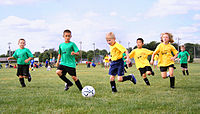
Photo from wikipedia
BackgroundChildren participate in four main types of physical activity: organized sport, active travel, outdoor active play, and curriculum-based physical activity. The objective of this study was to develop a valid… Click to show full abstract
BackgroundChildren participate in four main types of physical activity: organized sport, active travel, outdoor active play, and curriculum-based physical activity. The objective of this study was to develop a valid approach that can be used to concurrently measure time spent in each of these types of physical activity.MethodsTwo samples (sample 1: n = 50; sample 2: n = 83) of children aged 10–13 wore an accelerometer and a GPS watch continuously over 7 days. They also completed a log where they recorded the start and end times of organized sport sessions. Sample 1 also completed an outdoor time log where they recorded the times they went outdoors and a description of the outdoor activity. Sample 2 also completed a curriculum log where they recorded times they participated in physical activity (e.g., physical education) during class time.ResultsWe describe the development of a measurement approach that can be used to concurrently assess the time children spend participating in specific types of physical activity. The approach uses a combination of data from accelerometers, GPS, and activity logs and relies on merging and then processing these data using several manual (e.g., data checks and cleaning) and automated (e.g., algorithms) procedures. In the new measurement approach time spent in organized sport is estimated using the activity log. Time spent in active travel is estimated using an existing algorithm that uses GPS data. Time spent in outdoor active play is estimated using an algorithm (with a sensitivity and specificity of 85%) that was developed using data collected in sample 1 and which uses all of the data sources. Time spent in curriculum-based physical activity is estimated using an algorithm (with a sensitivity of 78% and specificity of 92%) that was developed using data collected in sample 2 and which uses accelerometer data collected during class time. There was evidence of excellent intra- and inter-rater reliability of the estimates for all of these types of physical activity when the manual steps were duplicated.ConclusionsThis novel measurement approach can be used to estimate the time that children participate in different types of physical activity.
Journal Title: BMC Public Health
Year Published: 2018
Link to full text (if available)
Share on Social Media: Sign Up to like & get
recommendations!